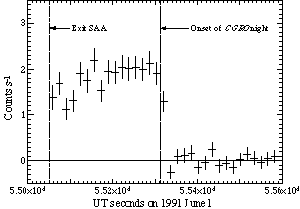Back To OSSE Solar Flare Web Page
1991 June 1 (X12+)
A GOES X12+ solar flare occurred on 1991 June 1 saturating the GOES detectors for more than 25 minutes. The soft X-ray flux began at 14:56 (53780 s) UT and lasted for more than 2.5 hours. The flare was located 6-9 degrees beyond the limb of the Sun. During the peak of the flare, OSSE was shutdown down due to an SAA passage, but the peak was well-observed by the PHEBUS instrument on Granat in Earth orbit. In spite of the flare location, hard X-rays and gamma rays were observed. The gamma-ray emission is thought to have originated from thin-target interactions in the corona above the active region (Barat et al. 1994, ApJ, 425, L109, Ramaty et al. ApJ, 479, 458). This is in contrast to the thick-target interactions occurring low in the solar atmosphere thought to be responsible for emission from flares located on the solar disk.
When OSSE resumed observations about 750 s after the peak, it was pointed ~100 degrees away from the Sun observing the black-hole candidate Cygnus X1. At 100 degrees off axis, OSSE still has good sensitivity to high-energy gamma rays and neutrons and some response to ~MeV gamma rays. Because of SAA contamination, a reliable OSSE background-subtracted gamma-ray count spectrum could not be obtained. However, the count rates of both the 4-7 MeV gamma rays and the >16 MeV neutrons showed sudden decreases at satellite night which occurred about 260 s after exiting the SAA. The background-subtracted count rate of events attributed to neutrons is shown in Figure 1. OSSE clearly observed neutrons from the June 1 flare. However, some or all of the 4-7 MeV counts could be due to partial energy depositions of higher-energy neutrons rather than gamma rays from the Sun.
Detection of high-energy neutrons from the June 1 flare is surprising if the emission were indeed from the corona. In a paper accepted for publication in the Astrophysical Journal (Murphy, et al. 1999, ApJ, 510 #2), we have compared the June 1 gamma-ray and neutron observations with the same quantities observed by OSSE from the 1991 June 4 flare. We showed that the accelerated particles must have a very hard spectrum to account for the number of neutrons observed if they were produced by thin-target interactions in the corona..
 Figure 1 |